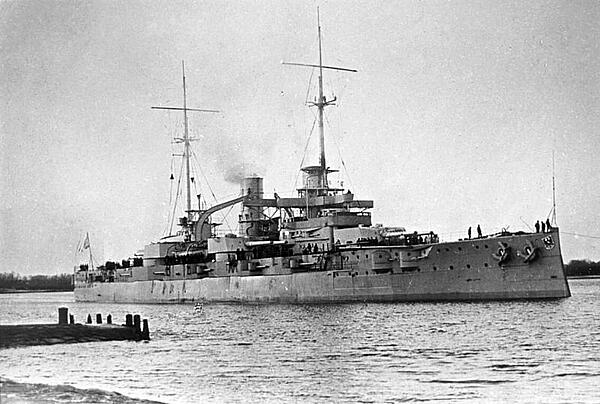British Submarines and the Baltic Sea
The use of British submarines during World War One was highly controversial, but their successes in the Baltic Sea boosted their reputation among some of the more reluctant members of the Admiralty.
It was actually Admiral John Jellicoe who gave the order for submarines to be sent to the Baltic on 17 September, and by the end of 1915 it had proved to be a significant success. Records state:
“During the whole course of the war, nothing has occurred more dramatic than the successes achieved by British submarines in the Baltic. Their actions cannot fail to have an influence on the course of the war.” (US Naval Proceedings 1915)

The route between the North Sea and the Baltic Sea was naturally very dangerous. The Sound, the area to the east of Denmark, combined salt and fresh water, which led to different areas experiencing different water densities, depending on the combination. As a result of these, it was notoriously hard for submarines to maintain and constant depth, particularly in the Sound where the water was no deeper than 35 feet. The journey was complicated further still thanks to the lights from the nearby towns, which made navigation even more difficult. To solve this problem, British submarine commanders were ordered to follow a neutral ship into the Baltic at night so they were ready to attack the enemy fleet once inside.
Once the Kiel Canal was extended to allow Germany use of the Baltic Sea for naval exercises and importing food, Britain was perfectly positioned to stop them. By the end of 1915, merchant vessels completely refused to travel from Sweden to Germany unless they were accompanied by a convoy, which was made almost impossible by the fact that the German Baltic and High Seas Fleets were trapped.
The most important part of this campaign against merchant ships was the halting of the transportation of iron ore from Sweden, which forced the German military to source it elsewhere in greater quantities. This reduced the efficiency of the German troops and prevented them from reaching their full potential.
The influence of the British submarines on the Baltic became so significant that the German High Command believed there was a huge fleet operating out of the sea with its own supply vessel. However, there were actually only five E-class submarines in the Baltic, which was around one third of Britain’s total long distance submarine fleet at the time.
One of the most significant days in the campaign of submarines in the Baltic was 11 October 1915, when E19, commanded by Lieutenant-Commander Cromie, sank a total of five merchant ships in one day. There was 20,000 tons of iron ore on the ships, which made it a significant loss for Germany and also prompted a complete standstill of merchant ship movement due to the increase fear. US Naval proceedings of 1916 said:
“The ports from which iron ore and timber are exported are crowded with vessels which dare not put to sea owing to the activity of underwater boats.”
The psychological impact of the submarines was so great that it prevented merchant ships from sailing for years, with the number of targets only reducing when the Germans introduced a convoy system in 1916.
Each individual submarine played a role in weakening the Germans including E9, which raided Kiel harbour and forced two squadrons of heavy capital ships and fifteen destroyers to be redirected to the harbour in an attempt to detect it. Prince Henry of Prussia, German Commander-in-Chief, summed up their impact when he said:
“I consider the destruction of a Russian submarine a great success, but I regard the destruction of a British submarine as being at least as valuable as that of a Russian armoured cruiser.”
This impact was increased further when three more E-class submarines were sent to the Baltic, preventing the German fleets from training. Germany attempted to attack the fleet but suffered heavy losses, leaving them vulnerable. This problem was exacerbated by the fact that the Germans had very few natural harbours in the Baltic, making it easy for the British submarines to patrol.
Britain’s submarines also had a significant impact on other parts of the war, such as the ongoing battle between Germany and Russia. In 1915, for example, the Germans planned a major attack on Riga, Russia, which would use a land fleet and a supporting naval fleet. In total, Germany sent 15 battleships, 13 cruiser and 71 destroyers, which were designed to protect the other ships from British submarines. However, on the fleets outward journey British submarine E1 severely damaged heavy cruiser “Molte”. Admirals Schmidt and Hipper immediately turned around their fleet and returned to Danzig, desperate to avoid having their fleet sunk by the subs. Without naval support, the attack failed and the action was cancelled, and Nicholas II thanked Lieutenant Commander Laurence for saving the town.
Sadly, the introduction of convoys made it difficult for this success to continue in 1916. Where the submarines had previously approached merchant ships, asked them to evacuate and then destroyed their cargo with no loss of life, this luxury was taken away once destroyer convoys were present.
The blockade of German ports ultimately had a huge impact on Germany, forcing food prices to rise and shortages to take hold. The submarine was crucial to the success of this campaign, arguably having an impact on the German sailors, who refused to take part in the planned ‘last stand’ against the British Navy in 1918. Although the direct impact of British submarines on this German Navy mutiny is hard to assess, it is generally accepted that the Germany Navy had a strong fear of the subs, so it’s likely the E-class submarine had a significant impact on this action.
MLA Citation/Reference
"British Submarines and the Baltic Sea". HistoryLearning.com. 2025. Web.
